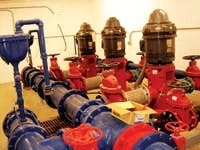Wireless communications have become a viable choice for monitoring and control needs in water and wastewater treatment. Despite the many radio communication frequencies available around the world, unlicensed frequency-hopping spread spectrum (FHSS) radios still offer a compelling argument for use in today’s SCADA networks where serial or Ethernet data communications are deployed.
Looking at the latest technology offered by some companies, FHSS radios provide decent data speeds—around 1 Mbps. Other key features available today include multiple serial and Ethernet connections, frequency zone elimination, data encryption, virtual private network (VPN) tunneling, MAC filtering, terminal servers and built-in Web browsers. These features offer advantages in many instances, and continue to support the case for utilizing all of the benefits that spread spectrum wireless data radios offer.
Radio manufacturers are developing several new products to help satisfy the demand for reliable spread spectrum communication. There are input/output (I/O) radios in both 900 MHz and 2.4 GHz frequencies and a new series of products that include I/O expansion modules utilizing Modbus protocol, the industry standard. Adding I/O into networks that already have serial radios is an easy task, and if repeaters are needed, they can be added to the radio network. Adding I/O can help increase the scope of monitoring tank levels, as well as pump control (on or off). Also available are software tools that can read and program the radios, update firmware, create network design templates and gather diagnostics from the same software. Water and wastewater operators can create a network design and program the radio for each specific location and know that it has all of the correct radio settings required.
Common Operator Concerns
While the demand for spread spectrum radios has continued to increase, some water and wastewater operators are still resistant to this technology. Proper research about wireless data radio providers can address the following common concerns:
Difficult terrain. It is essential to complete a path study—whether computer generated or physical—that addresses potential issues with difficult terrain. It is important for operators to choose a company that will take the time to ensure line-of-sight issues are addressed and resolved prior to installation. Radio companies can assist with the radio path studies and radio frequency network design to ensure that operators will have a good understanding of the radio frequency network and how it will work before they deploy it.
The network already is saturated. In a high-noise environment, data reliability is dependent upon a high signal-to-noise ratio.
In many highly-populated areas, there is not very much room in the radio spectrum. Licenses are jam-packed, sometimes to the point that one can hear two or more sites on the same frequency at once. Therefore, considerable research and development has gone into creating spread spectrum radios that can work in close proximity to each other and share the same frequency bands. To accomplish this goal, radio networks are programmed to share common bands, but use separate frequencies.
Spread spectrum solutions did not work in the past. Operators must consider the fact that not every spread spectrum radio provider is equal. Before implementing a system, it is critical to evaluate its basic communication needs. Operators can ensure they have selected an ideal provider by asking questions that will help them determine whether all needs are being met. A reliable wireless data radio provider will lead the charge in helping operators ensure their communication devices work seamlessly with the SCADA communication network.
Ethernet connection is a requirement now. In the past, most spread spectrum radios offered serial connectivity. Today, Ethernet has become the new standard for wireless communication. There are wireless providers that offer new spread spectrum solutions with Ethernet and serial ports, allowing utilities to easily convert to Ethernet communications and also provide backwards compatibility for previously installed serial communication networks. This allows for future technologies and simpler installation by easily integrating into an existing system.
Security. FHSS wireless systems are resilient when it comes to impairments such as interference—deliberate or coincidental—and “jamming,” because they use only small amounts of the radio spectrum at a time and do not dwell at a specific frequency long. Instead, the radios “hop” to another frequency quickly. This makes Denial of Service (DoS) attacks on FHSS systems very difficult, if not completely impossible. Additional methods for encryption and deciphering add another layer of security to many of these technologies.
Hybrid Networks
There is not always a single solution that can meet all of a system’s needs. Some operators may find that taking a “hybrid” approach can be best. Hybrid communication networks can have several variations of radio type and frequency, and can be licensed or spread spectrum. In addition, Ethernet, serial and I/O all can work together as an integrated communication network. Oftentimes, the best solution is not a single technology, but a mixture of two or three different types. By upgrading critical sites and adding new technology when needed, end users often can get the best results for their investment.
The Right Radio Provider
Conducting research and asking questions helps operators obtain the ideal communication network. Spread spectrum radios continue to offer reliable, secure communications; it is just a matter of finding the right radio provider. Path studies are critical in helping resolve line-of-sight issues, saturation issues and ensuring proper network design. Many spread spectrum radio companies continue to develop new radios to meet their customers’ needs, such as the addition of Ethernet ports. When the right system is in place it directly impacts the bottom line, decreases polling cycle times, reduces the time needed to identify and rectify problems within the network, and eliminates system “pinch points,” or single points of failure.
Download: Here


